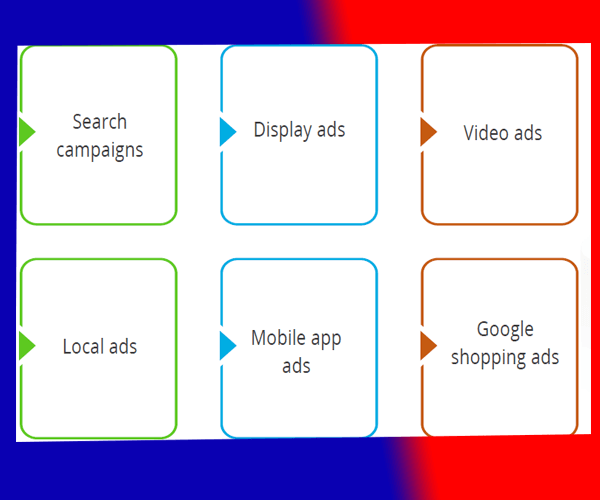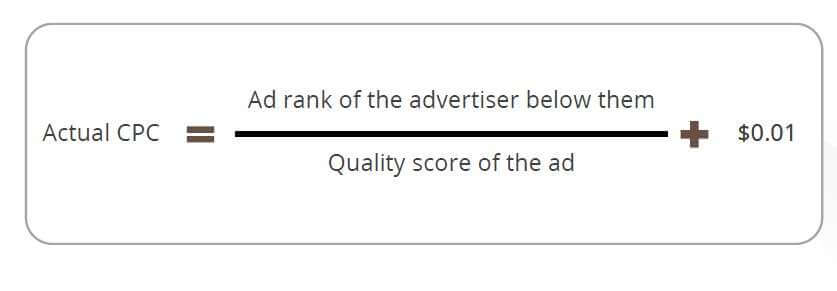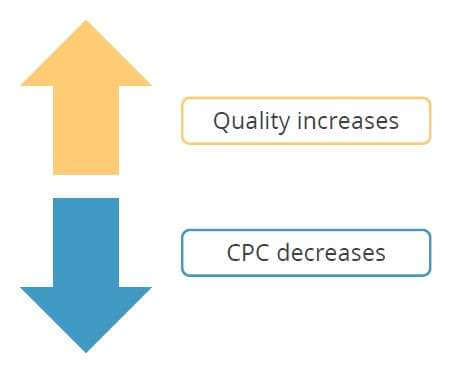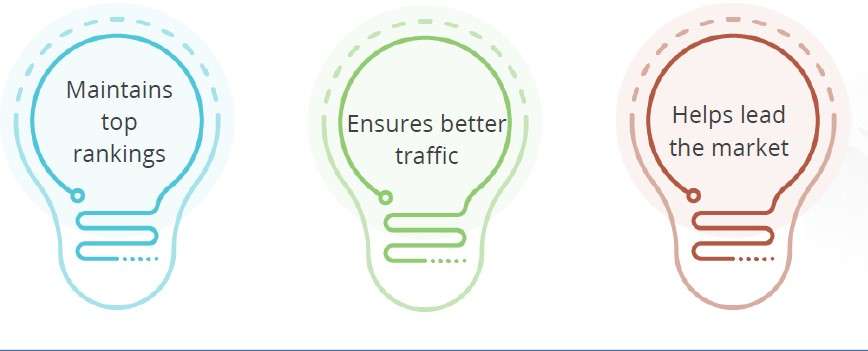Search Engine Marketing (SEM)
What is search engine marketing (sem) ?
Search Engine Marketing is a powerful tool for growing business online. It helps businesses connect with their target audiences by increasing visibility on search engine results pages (SERPs). It refers to the use of paid advertising to promote traffic. It is done with the help of platforms like: Google Ads, Bing Ads, Yahoo Ads
Paid search ads are essential component of SEM and appear at the top of search results pages.
SEM: Significance
- Helps businesses promote their products and services online
- Helps companies raise their SERP ranking
- Enables companies connect with potential clients
- Helps businesses increase their online visibility
Benefits of SEM
- Generates leads
- Increases brand awareness
- Reaches target audiences
- Measures ROI
- Provides transparentand real time reporting
- Helps set upcampaigns quickly
SEM vs. SEO
sem
- Focuses on paid ads at the top of
SERPs - Involves promotion of websitesthrough paid advertising
- Is a short term strategy
- Is expensive
- Helps a website reach out to targetaudiences quickly
seo
- Focuses on optimizing a website for organic search results
- Improves website ranking throughorganic search algorithm
- Is a longterm strategy
- Is affordable
- Helps build credibility for a website
Popular SEM Platforms
Google Ads :
It is a powerful advertising tool offering great flexibility.
- Targets specific demographics
- Saves money
- Creates brandawareness
- Increases website traffic
- Achieves sales
Why Use Google Ads ?
- Tackles competitors better
- Measures performance consistently
- Reconnects withvisitors
- Runs faster than SEO
- Promotes brand awareness
- Reaches more customers
Why Google Ads Works Faster Than SEO ?
Google Ads outperforms SEO because it:
- Is transparent andresult-oriented
- Places ads on the top of a web page
- Focuses on multiplekeywords at a time
- Gives authority to turn on and off the campaign
Types of Google Ads Campaigns

Key Terms in SEM and Google Ads
- Search query : A set of words entered by the user into a search prompt
- Keywords : Words or phrases based on which the bid is placed
- Maximum cost per click: The maximum amount that an advertiser will pay for a keyword
- Impression: Each instance where an ad is displayed on a search page
- Impression share : The number obtained by dividing the number of times an ad isdisplayed by the number of times it could have been displayed
- Conversion: An action that takes place when a defined set of actions iscompleted by the user
- Payper click: An advertisement costing model where an advertiser pays only when a user clicks on the ad
- Search engine results’ page: The page displaying the query’s search results
Google Ads Auction
Google Ads determines eligible ads for :
- Search query
- Ad position
Google Ads returns approximately 5x to 8x for every $1 spent.
Ads: Factors
The three factors that determine ads are :

Ad Rank
Ad Rank determines ad placement on SERP.
The quality components of ad rank can influence:

Ad Rank = Maximum bid * Quality score
Ad Rank factors
- Maximum bid
- Ad extensions and formats
- Search context
- Quality score
- Ad Rank thresholds
- Auction competition
Quality Score
It guides marketers in adapting their campaigns based on keyword evaluation,landing sites, and advertising.
Ad rank = Maximum bid * Quality score
The quality score determines ad placement (ad position) on the search engine result page.
Factors of Quality Score
Google considers many keyword related and other parameters such as:
- Click through rate
- Keyword and ad text relevance
- Landing page experience
- Past ad account performance
Cost per Click
It is the amount advertisers pay based on the number of clicks.
- Maximum CPC : It is the highest bid set for a click on the ad at the keyword or ad group level.
- Average CPC : It is the advertiser's payment for a single click on their ad.
- Actual CPC : It is the amount that an advertiser pays each time a searcher clicks on their ad.
Google determines the CPC based on the maximum bid, quality score, and keyword competition.
Ad Rank and CPC
Google uses the ad rank of the next best ad to calculate CPC. Lone bidders pay the maximum amount per click.

Ad Rank and CPC
Ad rank and CPC are inversely related.

Keywords
Keywords are the foundation of Google Ads as they help in describing products or services.
Features
- Relevant, highquality keywords determine where theAds are displayed.
- The right keywords target interested individuals andboost conversion chances.
- They are used in online searches for products or services.
- Ads appear based on keyword similarity and matchtypes when people search on Google.
Rules to follow while incorporating keywords:
- Rules to follow while incorporating keywords:
- Use in the first paragraph
- Use keywords inthe title, meta tag,description, imagetext, and URL
- Use on ads andsocial media post
Poor keywords
- Overshot budget
- High cost
- Low ad positions
Good keywords
- Reaching interested customers
- Reducing costs
- Improving ROI
Search Term
It is the specific word or phrase used to search for particular information.
Keywords vs. Search Terms
Keywords
Words chosen toshowcase adsExample: Car insurance
Search terms
Words searched by users on Google Example: Best car insurance or cheapest car insurance
Keyword Match Types
They restrict unqualified or irrelevant traffic. Keywords are four types :
- Broad match: Smart bidding option
- Exact match: Exact keyword is matched
- Phrase match: Same meaning as the keyword
- Negative keyword match: Debar the audience
Broad Match
Broad match triggers ads for searches with any words in a keyword phrase, in any order,and with extra terms. Google Ads and Bing Ads use it as the default matching type.
Phrase Match
It is a keyword match type that targets ads to customers searching for specific phrases. A phrase match keyword is enclosed in quotation marks. ”women’s hats””baby shoes”
Phrase Match in Google Ads
It is a keyword match type that targets ads to customers searching for specific phrases. It is an option that exactly matches the search phrase without any change. A phrase match keyword is enclosed in quotation marks. ”women’s hats””baby shoes”
It helps advertisers reduce their ad budget.
Exact Match
It shows ads only when the exact keywords are used in the search query.It encloses the desired term in square brackets: [men’s shoes]
Keyword Research
It is a process of analyzing search terms. It is an effective way to increase website ranking. Good keyword research has the following benefits:

Google Ads Account Structure
Google Ads account structure is essential for businesses using it for marketing. It is easier to track progress and measure results with a well structured account. Importance of Google Ads Account Structure :
- Increases return on investment
- Maximizes efficiency
- Makes real time adjustments
- Tracks performance
- Makes informed decisions
- Increases visibility
- Targets specific customer group
- Optimizes campaigns
Understand Campaigns and Ad Groups
Campaigns
They focus on the following:
- Increase brand awareness
- Drive website traffic
- Improve sales
Ad groups
They target customer types based on :
- Location
- Gender
- Age
Follow these practices for effective campaigns.
- Align the account structure
- Utilize multiple ad groups
- Take advantage of automation features
- Make use of ad variations
- Differentiate between campaign types
- Differentiate between campaign types
- Use keywords to get more clicks
Managing Access for Google Ads Account
- The access level can be managed while inviting users.
- Users can revoke, edit, or grant access toothers from the Action column
- Access levels can be controlled byadministrator accounts.
Measurement Metrics in Google Ads
Some metrics that help understand the performance of ads are:
- Engagement
- Reach
- Frequency
- Impressions
Calculation of Metrics
It determines success and learns from successes and failures, providing valuable insightsfor future campaigns. Key metrics for measuring performance are:
- Clickthroughrate (CTR)
- Impression
- Conversion
- Conversion rate
- Average cost per click (cpc)
- Cost per acquisition (cpa)
Click through Rate (CTR)
CTR = Clicks / Impressions*100
• It measures the frequency of ad clicks after being seen.
• It indicates the relevance and appeal of the ad to the audience.
• A high CTR signifies effective engagement and interest from the target audience.
• A low CTR may indicate issues with targeting or ad creativity.
Impression
It refers to the number of times the ad gets displayed on the Google search result page. Advertisers get charged when users click their ads.
• It represents the reach and frequency of display.
• The low impressions may result from irrelevant keywords or insufficient targeting.
• It can be improved through relevant keyword targeting, optimized budget, and compelling ad creative.
Conversions
It measures the frequency of desired actions taken by users who see the ad.
• It indicates whether the ad campaign achieves its objectives.
• Low conversions may be due to irrelevant ads or poor design.
Conversion Rate
• It displays the percentage of users who complete the desired action.
• It can be improved by ensuring the ad is relevant to the targeted keywords.
• Low conversion rate indicates users leaving without taking action.
• Leads, sales, and add to cart are examples of conversion rates.
Conversion rate = Total goal completions / Total website visits*100
Average Cost Per Click (CPC)
It refers to the amount paid to Google for each click on the ad.
Average CPC =Total cost of clicks / Total number of clicks
•It varies based on ad type, keywords, and user location.
•Google search ads generally have higher CPC compared to other ad types.
Cost Per Acquisition (CPA)
It is the average price paid to Google for each conversion.
•It reflects the average spending to acquire new customers.
•It varies based on conversion type and keywords.
Activity: Calculation of CPC
1000 dollars were paid for a campaign, and the ad was shown 1000 times.20 people clicked on the ad, and the user received 4 leads. What is the conversion rate?
The cost of getting an ad clicked is measured using the average cost per click statistics.
CPC = (Total ad spent/Total clicks) = (1000/20) = 50
CTR = (Clicks/Impressions) * 100 = (20/1000)*100 = 2%
Conversion rate = (Goals/ Website visits) * 100 = (4/1000)*100 = 0.4%
Search Ads
It is a marketing strategy that integrates digital ads into search engine results. The two types of search ads are:
- Standard search ads : They are paid advertising on the SERP to boost website visibility.
- Dynamic search ads : They place ads on SERP from approved URLs andtargeted keywords.
Dynamic Keyword Insertion
It is a technique used by Google Ads professionals to improve the effectiveness of ads. The process includes:
Identifying thekeywords
Adding them tothe ad copy
Result :
•High CTR
•Increase in conversion rates
Creating a Google Search Ad Copy :
Tips for writing a Google search ad copy are:
- Keep it short
- Use apt keywords
- Write for audience
- Test different versions
- Focus on benefits
Benefits of Search Ads
- Connect with customers
- Create branda wareness
- Increase sales and leads
- Target specific individuals
Google Ad Extensions
It is a marketing tool that displays extra details about a product or service. Types of Google ad extensions are:
- Sitelink extensions
- Call extensions
- Location extensions
- Product extensions
- Structured snippet extensions
- Message extensions
- App extensions
- Callout extensions
Google Ad Extension: Benefits
- Increases CTR and quality level : Provides additional information and entices users to click on ads
- Provides competitive edge : Offers added value to ads, helps it stand out from competitors, and attracts more attention from potential customers
- Improves conversion rate : Conveys more information at no costs and makes the ads attractive
- Increases engagement with brand: Provides additional details, such as contact, location, and links tocreate a compelling ad
- Enhances visibility : Gains more visibility by making ads easily accessible to potentialcustomers
- Has a positive influence on pricing and ranking : Makes ads valuable for optimizing advertising budgetby i nfluencingthe price paid for adsHas a positiveinfluence on pricingand rankingMaximize
- Lorem Ipsum is simply dummy textIncreases CTR and quality level : Provides additional information and entices users to click on ads
Remarketing
It refers to personalized ad campaigns for users who previously visited the website. It aims at targeting customers by developing custom ads for users who interacted with the brand earlier.
How Does Remarketing Work?
- A user visits a website.
- Google places a pixel in the user’s browser to track their activity. The
- The tracking code collects information about the user’s visit.
- This information is used to target potential customers.
Google Ads reconnects with users through display or search ads.
Steps to Create Remarketing Audiences on Google Ads
- Install the conversion tracking code
- Set up audiences
- Create remarketing campaigns
- Monitor and optimize campaigns
Understanding Cookies
Cookies are small text files that websites save on the user’s computer. They are used to store preferences and track users’ online activity.
Types of Ads
There ate three types of ads : display ads, video ads and
Display Ads
These are online advertisements that use visual elements to convey a message to the target audience. Some goals are :
- Educate about the product
- Provide entertainment
- Encourage users to take action
- Eliminate the need for direct communication
Metrics for Evaluating Display Ads
- Cost per click (CPC) : Indicates the cost ofeach click
- Cost per acquisition (CPA) : Indicates a visitor’s interaction with an ad
- Cost per impression (CPI) : Indicates the numberof times an ad is displayed on a website
- Cost per mile (CPM) : It measures how much is paid for every thousand impressions.
Factors Influenced by Display Ads
- Reach: Number of peopleseeing the ad
- Click through rate: Number of users who click on an ad
- Conversion rate: Percentage of peopleconverted from the ad
- Revenue per mile: Revenue generated per thousand impressions
Display Ads: Formats
Medium rectangle
(MREC):
300px x 250px
Large
rectangle:
336px x 280px
Leaderboard:
728px x 90px
Half page:
300px x 600 px
Large mobile banner: 320px x 100px
Types of Display Ads
- Responsive Display Ads : Automatically adjust their appearance to fit into available ad spaces onthat specific website
- Image Display Ads : Are feature images that takes the user directly to the webpage when clicked
The images can be animated, static, or GIFs - Overlay Ads : Are transparent and allow to see the content behind them
- Rich Media Ads: Pop-up videos that autoplay when the page loads or ads that expand when scrolled over them
- Banner Ads : A digital billboard with imagery to attract attention to drive traffic to he advertiser's site
- Interstitial Ads : Full-screen ads used to encourage sign-up
Metrics for Google Display Ads
- Impression: Counts when an ad is served, not clicked
- Clicks : Number of user clicks on an ad
- CTR : Shows how effective an ad is at getting users to click on it
- CPC : Maximum amount advertiser is willing to pay for each click
- Conversion rates: Number of actions taken after clicking the ad
- CPM : Cost for 1000 ad impressions
- CPA : Cost to convert a click into a customer or lead
- Average position : Average placement of the ad on Google
Benefits of Display Network
- Publishe stargeted graphic ads on websites
- Shows videos on YouTube
- Advertises through Gmail
- Advertises through mobile devices and applications
- Helps in finding the right audience
Some Display Networks
- Google AdSense : Holds their advertisers tostrict standards of quality
- Facebook Audience : Is easy to use and intuitive enough for any advertiser to see results
- Apple Advertising : Has an intuitive bidding andtargeting system
- Yahoo Network : Is costeffective and has arobust display network
Discovery Ads
These drive sales, signups, and website visits with high conversion rates.
Features
- Help to reach and engagepotential customers
- Perform automated campaign bidding
- Focus on visually attractive ads
- Focus on relevant campaigns
- Use AI based machine learning
Video Ads
These can be used to, Promote products, Drive traffic to the website, Reach potential customers, A successful video campaign requires compelling content and optimization.
Steps to Create Video Ads
1. Map video relevance to search results through keyword labels
2. Include a transcript of the audio portion of the video
3. Deploy captions and grab thumbnail images
4. Use video schema markup4
Advantages of Video Ads
- Provide viewers with information about the product description and attitude of the company
- Provide a view of the details of the cost and budget on the same page
- Help get results quickly
- Create an opportunity for small businesses, startups, and enterprises
- Lead to more sales and revenue
Types of Video Ads
- Demonstration videos: Show how to do art,cooking, videoediting, and so on
- Informational videos : Share how or whatto do and educate the audience
- Storytelling videos: Includewriting a script orcreating a vlog
- Testimonial videos : Examine what otherpeople think abouta product or service
Shopping Ads
They are online ads showcasing products on Google and partner sites. It is majorly preferred for fastmoving consumer goods (FMCG) products. Brands like Croma and Amazon use shopping ads to target multiple products. It has the following features:
Consists of an image, price, and product name
Promotes products online and drives sales
Shopping Ads: Benefits
- Allow measuring campaigns
- Have easy and flexible setup
- Provides wider reach
- Bring higher visibility for products
- Generate positive ROI
- Target interested customers
- Provides optimized solutions for mobile
Our Company